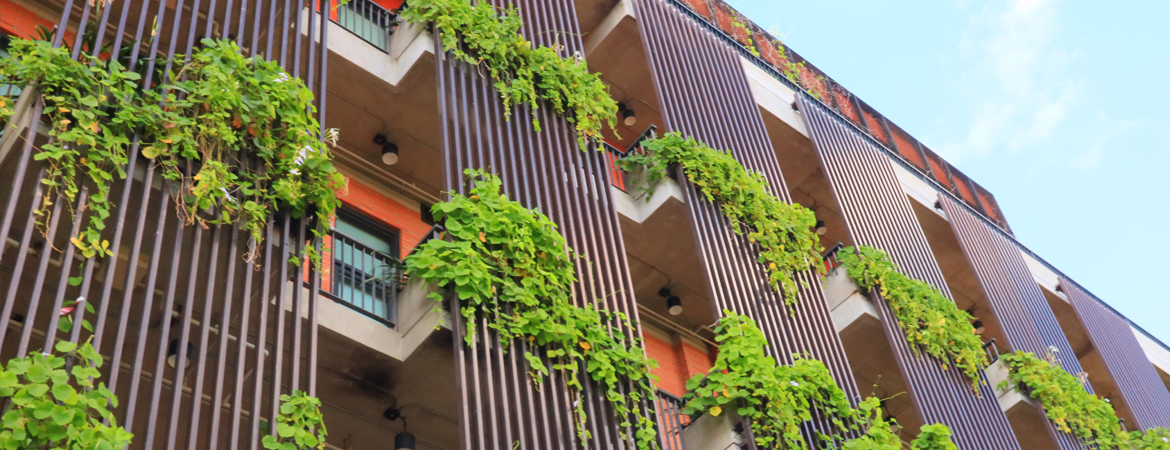By Emma Sorrell

In an era of heightened climate consciousness, sustainability has evolved from a buzzword to a driving force in the hospitality sector. Leading hotel brands are stepping up to meet the demands of an increasingly climate-conscious consumer base and address growing concerns about their environmental footprint. According to the U.S. Travel Association, “nine out of 10 travelers want more sustainable travel options and 76% of business executives want sustainable corporate travel choices — even if it costs more.”
While sustainability measures often deliver cost savings over time, some infrastructure-based strategies carry a heavy upfront price tag. This is especially salient with energy: it is the biggest lever that building developers and owners can pull to reduce greenhouse gas (GHG) emissions but tends to come with significant capital investment costs. However, there are tried and tested approaches for identifying strategies that will maximize both cost savings and environmental benefits from energy measures. Identifying the right energy conservation measures (ECMs) investments for hospitality properties, and how to prioritize them from the very beginning is key.
Identifying the Right ECMs: The Energy Procurement Loading Order
Initially, it can be tempting to gravitate toward high-impact investments in advanced energy technologies such as solar photovoltaic (PV) and battery storage systems. These can seem opportune as a first step, as they reduce GHG emissions and offer important visible symbols to guests of a brand’s commitment to sustainability. However, jumping to distributed energy sources and focusing on energy generation overlooks a critical step: reducing energy consumption. Without addressing energy demand first through cost-effective energy efficiency retrofits, properties are missing a significant opportunity for cost savings and run the risk of oversizing and overpaying for distributed energy resource solutions like solar and storage.
This strategic approach, known as the ‘procurement loading order,’ has been embraced by utility companies and outlines a hierarchy of solutions that prioritize cost-effective energy efficiency strategies first before turning to more expensive strategies like onsite renewable energy – without compromising efforts to reduce carbon footprint.
A Top-Down, Bottom-Up Approach for Prioritization– Starting with Energy Audits
To identify and prioritize ECMs, hotels, and hospitality brands should start with energy audits. These are comprehensive assessments of all energy-consuming systems that scrutinize lighting, mechanical, building controls, water fixtures, and building envelopes, and uncover the best opportunities for energy savings. For the hospitality sector, significant energy conservation can be achieved through LED lighting, in-room occupancy sensors, variable frequency drive pool pumps, faucet aerators, high-efficiency HVAC systems, and condensing boilers. The electrification of appliances like induction cookers and heat pumps can also reduce the demand for natural gas.
However, critical groundwork is needed before embarking on energy audits. Hotels should take steps to achieve alignment between corporate management and local staff with respect to decision-making drivers, which can extend beyond financial metrics (e.g., net present value, internal rate of return) and encompass non-financial considerations such as GHG emissions reduction and climate resilience. These factors will enable hospitality brands to complete holistic evaluations of different building and energy measures based on holistic benefits and costs. The result will provide hospitality properties with a prioritized list of the most impactful measures to be implemented.
While retrofitting energy systems is effective for existing properties, proactively incorporating these measures into brand development standards for new builds will maximize savings by limiting the installation cost to the incremental cost difference relative to conventional equipment.
More than ever, there is a critical relationship between sustainability and the hospitality sector’s economic and operational efficiency. By pivoting towards energy efficiency and embracing other ECMs, owners can not only experience rapid returns on investment but also establish enduring reductions in their carbon footprint and overall environmental impact.
About the Author
Emma Sorrell serves as the Senior Director of Cumming Group’s Energy and Sustainability team, where she brings extensive expertise to oversee sustainability strategic planning, program development, and project implementation services. With a broad spectrum of experience, Emma specializes in climate action planning, sustainable procurement, water conservation, waste reduction and diversion, and behavioral changes across the building industry.
